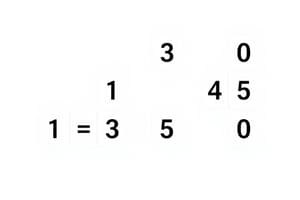Podcast
Questions and Answers
What are the three steps in the basic plan for mergesort?
What are the three steps in the basic plan for mergesort?
- Divide the array into two halves. 2. Recursively sort each half. 3. Merge the two halves.
In the context of the abstract in-place merge demo, what is the goal?
In the context of the abstract in-place merge demo, what is the goal?
Given two sorted subarrays a[lo] to a[mid] and a[mid+1] to a[hi], replace with sorted subarray a[lo] to a[hi].
What condition must be met to stop the standard mergesort algorithm early (before merging) and what type of arrays benefit most from this optimization?
What condition must be met to stop the standard mergesort algorithm early (before merging) and what type of arrays benefit most from this optimization?
Stop if the largest item in the first half is less than or equal to the smallest item in the second half. Partially ordered arrays benefit the most from this optimization.
What is the key idea behind bottom-up mergesort, and how does it differ from the standard mergesort approach?
What is the key idea behind bottom-up mergesort, and how does it differ from the standard mergesort approach?
In terms of computational complexity, what is an 'optimal algorithm'?
In terms of computational complexity, what is an 'optimal algorithm'?
Explain the relevance of a 'decision tree' in the context of sorting algorithms' computational complexity.
Explain the relevance of a 'decision tree' in the context of sorting algorithms' computational complexity.
What is the significance of the statement: "Lower bound may not hold if the algorithm can take advantage of the initial order of the input"?
What is the significance of the statement: "Lower bound may not hold if the algorithm can take advantage of the initial order of the input"?
In the context of sorting algorithms, what does it mean for a sort to be 'stable'?
In the context of sorting algorithms, what does it mean for a sort to be 'stable'?
Of insertion sort, selection sort, shellsort and mergesort, which are stable?
Of insertion sort, selection sort, shellsort and mergesort, which are stable?
Explain why insertion sort is stable.
Explain why insertion sort is stable.
Explain why selection sort is not stable.
Explain why selection sort is not stable.
Explain why shellsort is not stable.
Explain why shellsort is not stable.
Explain why mergesort is stable.
Explain why mergesort is stable.
In terms of the 'running time estimates', how many compares per second can a laptop execute?
In terms of the 'running time estimates', how many compares per second can a laptop execute?
In terms of the 'running time estimates', how many compares per second can a supercomputer execute?
In terms of the 'running time estimates', how many compares per second can a supercomputer execute?
What is the number of compares $C(N)$ to mergesort an array of length $N$?
What is the number of compares $C(N)$ to mergesort an array of length $N$?
Mergesort uses ≤ how many array accesses to sort an array of length $N$?
Mergesort uses ≤ how many array accesses to sort an array of length $N$?
Mergesort uses extra space proportional to what?
Mergesort uses extra space proportional to what?
What is 'natural mergesort'?
What is 'natural mergesort'?
Name one algorithm that is now widely used and is 'natural mergesort'.
Name one algorithm that is now widely used and is 'natural mergesort'.
What sorting algorithm is commonly used for small subarrays within mergesort to improve performance, and why is it beneficial?
What sorting algorithm is commonly used for small subarrays within mergesort to improve performance, and why is it beneficial?
Explain the purpose of the 'eliminate the copy to the auxiliary array' optimization in mergesort and how it's achieved.
Explain the purpose of the 'eliminate the copy to the auxiliary array' optimization in mergesort and how it's achieved.
What is the primary advantage of using bottom-up mergesort over the standard recursive mergesort, and what is its main disadvantage?
What is the primary advantage of using bottom-up mergesort over the standard recursive mergesort, and what is its main disadvantage?
What is Timsort and what are its key features?
What is Timsort and what are its key features?
Explain what the term 'computational complexity' refers to in the context of algorithms.
Explain what the term 'computational complexity' refers to in the context of algorithms.
Distinguish between the 'Upper bound' and 'Lower bound' in computational complexity.
Distinguish between the 'Upper bound' and 'Lower bound' in computational complexity.
Why is mergesort considered an optimal algorithm?
Why is mergesort considered an optimal algorithm?
Is mergesort optimal with respect to space usage.
Is mergesort optimal with respect to space usage.
Java system sort uses what basic algorithm for sorting objects?
Java system sort uses what basic algorithm for sorting objects?
Which of the algorithms discussed can access information based only through compares.
Which of the algorithms discussed can access information based only through compares.
What is the 'complexity of sorting'?
What is the 'complexity of sorting'?
If $D(N)$ satisfies $D (N) = 2 D (N / 2) + N$ for $N > 1$, with $D (1) = 0$, then $D (N)$ = ?
If $D(N)$ satisfies $D (N) = 2 D (N / 2) + N$ for $N > 1$, with $D (1) = 0$, then $D (N)$ = ?
What is the key advantage of using comparators in sorting algorithms?
What is the key advantage of using comparators in sorting algorithms?
How does mergesort's space complexity affect its suitability for sorting very large datasets?
How does mergesort's space complexity affect its suitability for sorting very large datasets?
In what scenarios would you choose bottom-up mergesort over the standard recursive mergesort?
In what scenarios would you choose bottom-up mergesort over the standard recursive mergesort?
Describe a scenario where the stability of a sorting algorithm is crucial.
Describe a scenario where the stability of a sorting algorithm is crucial.
What are the typical steps involved in implementing a comparator in Java?
What are the typical steps involved in implementing a comparator in Java?
Explain what optimization is applied to MergeSort to help reduce running time when using Java 6?
Explain what optimization is applied to MergeSort to help reduce running time when using Java 6?
If you need to sort strings of varying case (both lowercase and uppercase), how would you use a Comparator to achieve case-insensitive sorting?
If you need to sort strings of varying case (both lowercase and uppercase), how would you use a Comparator to achieve case-insensitive sorting?
List the steps of how to create a 'natural order' sort.
List the steps of how to create a 'natural order' sort.
Flashcards
Mergesort Basic Plan
Mergesort Basic Plan
Divide array in half, recursively sort each half, then merge halves.
In-place Merge Goal
In-place Merge Goal
Given two sorted subarrays, replace with single sorted subarray.
Bottom-up mergesort plan
Bottom-up mergesort plan
Iterate merging subarrays in passes of increasing powers of 2
Computational Complexity
Computational Complexity
Signup and view all the flashcards
Model of Computation
Model of Computation
Signup and view all the flashcards
Cost Model
Cost Model
Signup and view all the flashcards
Upper Bound
Upper Bound
Signup and view all the flashcards
Lower Bound
Lower Bound
Signup and view all the flashcards
Optimal Algorithm
Optimal Algorithm
Signup and view all the flashcards
Decision Tree
Decision Tree
Signup and view all the flashcards
Stable Sort
Stable Sort
Signup and view all the flashcards
Mergesort optimality (compares)
Mergesort optimality (compares)
Signup and view all the flashcards
Mergesort optimality (space)
Mergesort optimality (space)
Signup and view all the flashcards
Comparable Interface
Comparable Interface
Signup and view all the flashcards
Comparator Interface
Comparator Interface
Signup and view all the flashcards
Study Notes
- Two classic sorting algorithms are mergesort and quicksort
- A full scientific understanding of mergesort and quicksort has enabled the development of practical system sorts
- Quicksort was honored as one of the top 10 algorithms of the 20th century in science and engineering
Mergesort Basic Plan
- Divide an array into two halves
- Recursively sort each half
- Merge the two halves
Abstract In-Place Merge Demo
- The goal is to replace two sorted subarrays, a[lo] to a[mid] and a[mid+1] to a[hi] with a sorted subarray a[lo] to a[hi].
Merging: Java Implementation
- An auxiliary array aux[] is used to copy the contents of the original array a[] during the merge operation
- The algorithm iterates through the specified range from 'lo' to 'hi'
- It compares elements and merges them back into array a[]
Mergesort: Java Implementation
- A
mergefunction combines two sorted subarrays into one sorted array - If the subarray is of length 1 or less, it returns immediately
- Breaks the array into two halves and recursively sorts those halves
Mergesort Number of Compares
- Mergesort uses ≤ N lg N compares to sort an array of length N
- The running time of mergesort can be represented by the formula C(N) ≤ C(⎡N / 2⎤) + C(⎣N / 2⎦) + N for N > 1, with C (1) = 0.
- Variable
Nis a power of 2 - Represented by formula D(N) = 2D(N/2) + N
Divide-and-Conquer Recurrence Picture and Induction Proof
- Proposition: If D (N) satisfies D (N) = 2 D (N / 2) + N for N > 1, with D (1) = 0, then D (N) = N lg N
- Proof 1 uses a divide and conquer strategy
- Proof 2 uses induction
- Base case: N=1
- Inductive hypothesis: D(N) = NlgN
- Goal: Show that D(2N) = (2N)lg(2N)
- Given the inductive hypothesis, D (2N) = 2 N lg N + 2N
- Can be simplified to D (2N) = 2 N lg (2N)
Mergesort: Number of array accesses
- Mergesort uses ≤ 6 N lg N array accesses to sort an array of length N
- Number of array accesses
A(N)satisfies recurrenceA(N) ≤ A(⎡N / 2⎤) + A(⎣N / 2⎦) + 6 N for N > 1, with A (1) = 0
Mergesort Analysis: Memory
- Mergesort uses extra space proportional to
N - The array
aux[]needs to be of length N for the last merge - A sorting algorithm is in-place if it uses ≤ c log N extra memory
- Insertion sort, selection sort, and shellsort are in-place sorting algorithms
Mergesort: Practical improvements
- Use insertion sort for small subarrays: Mergesort has too much overhead for tiny subarrays, cutoff to insertion sort for ≈ 10 items
- Stop if already sorted
- Eliminate copy to auxillary array
Studying That Suits You
Use AI to generate personalized quizzes and flashcards to suit your learning preferences.





